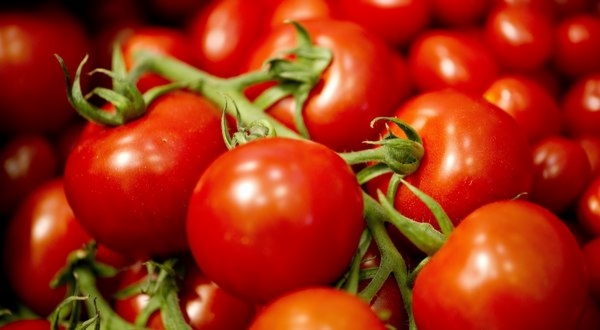The tomato, whose genome has just now been decoded, turns out to be one well-endowed vegetable, possessing 31,760 genes. This rich legacy, possibly a reflection of the disaster that killed off the dinosaurs, is some 7,000 more than that of a person, and presents a complex puzzle to scientists who hope to understand its secrets.
RSS Feed
A consortium of plant geneticists from 14 countries has spent nine years decoding the tomato genome in the hope of breeding better ones. The scientists sequenced the genomes of both Heinz 1706, a variety used to make ketchup, and the tomatos closest wild relative, Solanum pimpinellifolium, which lives in the highlands of Peru, where the tomatos ancestors originated. Their results were published online Wednesday in the journal Nature.
The tomato, though a fruit to botanists, has been decreed a vegetable by the United States Supreme Court. The verdict is not so unreasonable given that the tomato has a close cousin that is a vegetable, namely the potato. The genomes of the two plants have 92 percent of their DNA in common, the tomato researchers report. The main difference is that the potato is thought to have a handful of genes that direct the plants energy away from producing fruit and into the generation of tubers. But even with the genomes of the two plants deciphered, those genes have not yet been identified, said Daniel Zamir, a plant geneticist at Hebrew University in Jerusalem and one of the reports two principal authors.
The tomato genome is both of intrinsic interest and a key to understanding the very versatile family of plants to which it belongs. Besides the potato, the Solanaceae family, as it is known, includes the tobacco plant, the pepper, the eggplant and deadly nightshade.
That the tomato and potato contain so many genes does not mean that they are more sophisticated than people but that they have chosen a different stratagem for managing their cells affairs. Humans make heavy use of a technique called alternative splicing, which allows the components of each gene to be assembled in many different ways, so that one gene can produce many products.
The Solanaceae family, by contrast, has developed its genetic complexity through gaining more genes. About 70 million years ago, some lucky mishap in the process of cell division led to a triplication of the Solanum genome. The two spare copies of each gene were free to change through mutation. Many were useless and got dropped from the genome, but others developed useful new functions.
The tomato genome team has been able to visualize the result of this triplication by comparing the tomatos genome with that of the grapevine, a distant relative from which it parted company about 100 million years ago, well before the triplication event. Some of the grapes genes have a single counterpart in the tomato genome, some have two counterparts and some have three.
Usually the triplication of a genome would be a considerable handicap, saddling a plant with three times as much DNA as it needs. But this event occurred around the time of the catastrophe in which the dinosaurs perished, and the extra genetic versatility may have been a lifesaver. Its easy to think that in that period, with a lot of volcanic activity and little sunlight, the reservoir of a lot of additional genes would be useful to a plant, said Jim Giovannoni, a plant geneticist at the Boyce Thompson Institute for Plant Research in Ithaca, N.Y., who led the American contribution to the tomato genome report.
Plant breeders have had more success breeding tomatoes with features of interest to producers, like long shelf life, than with the traits that matter to consumers, like taste and quality, Dr. Giovannoni said. The tomato genome sequence may help redress the balance, since plant breeders can now rely on DNA as well as physical traits to govern their breeding programs, he said.
Written by Nicholas Wade for The New York Times, May 30, 2012.
FAIR USE NOTICE:This site contains copyrighted material the use of which has not always been specifically authorized by the copyright owner. We are making such material available in our efforts to advance understanding of environmental, political, human rights, economic, democracy, scientific, and social justice issues, etc. We believe this constitutes a ‘fair use’ of any such copyrighted material as provided for in section 107 of the US Copyright Law. In accordance with Title 17 U. S. C. Section 107, the material on this site is distributed without profit to those who have expressed a prior interest in receiving the included information for research and educational purposes. For more information go to: http://www. law. cornell. edu/uscode/17/107. shtml

